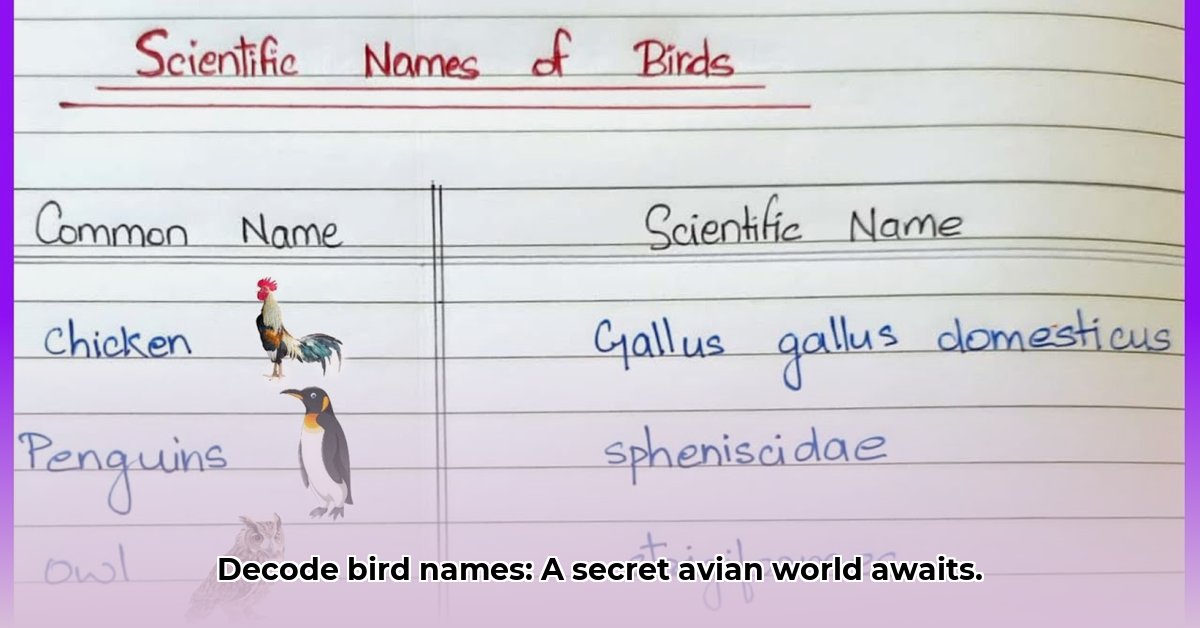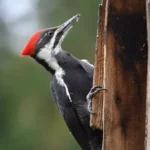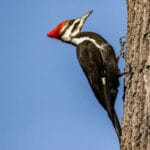Ever noticed how birds have two names – a common name like “robin” and a scientific one like Turdus migratorius? It might seem like overkill, but those scientific names are actually super important for understanding birds. This article explores bird classification, scientific names, why they’re used, how they work, and why they’re so useful for scientists and bird lovers alike. It’s like getting a secret code to unlock a really cool club – the club of bird experts!
Scientific Name for a Bird: Decoding the Avian Family Tree
Ever wonder why birds have those long, sometimes complicated, two-part names? It’s not just some scientific whim; it’s a crucial system for understanding and communicating about birds globally. This system, called binomial nomenclature, is like a secret code that ornithologists (bird experts) use to precisely identify every single bird species on the planet that improves species identification. It’s a much better system than using common names, which can vary wildly from country to country and even region to region. Imagine the utter confusion if everyone called the same bird by a different name!
This ingenious system, developed by Carl Linnaeus hundreds of years ago, provides a universally understood label for each bird species. It’s organized like a giant family tree, with branches and sub-branches, reflecting evolutionary relationships and shared characteristics. Think of it as giving every bird a unique address on the bird-family map.
Peeling Back the Layers: From Kingdom to Species
Classifying birds isn’t as simple as just looking at them. It’s a layered process, starting very broadly and becoming progressively more specific. We begin with the Kingdom (Animalia—because birds are animals!), then the Phylum (Chordata—they have a backbone!), Class (Aves—they’re birds!), Order, Family, Genus, and finally, the species. Each step narrows down the group, ultimately pinpointing one specific bird. This whole system helps us understand how different birds are related to each other, tracing their family lineage back through time. The scientific name for a bird gives us far more information than simply its common name – it reveals its place within the vast tree of life. For example, consider the Bald Eagle, its classification is as follows:
- Kingdom: Animalia (all animals)
- Phylum: Chordata (animals with a spinal cord)
- Class: Aves (all birds)
- Order: Accipitriformes (hawks, eagles, vultures)
- Family: Accipitridae (hawks and eagles)
- Genus: Haliaeetus (sea eagles)
- Species: Haliaeetus leucocephalus (Bald Eagle)
Why the Two-Part Name is So Important
A bird’s scientific name is always two parts: the genus and the species; this shows the importance of naming. This clever two-part naming system (genus and species) is essential for clear and consistent communication among scientists worldwide. It eliminates the ambiguity that comes with using common names. Research papers, databases, and international conservation efforts all rely on this consistent naming system. Scientists from different countries can look at the scientific name and know exactly which bird is being discussed, avoiding any confusion. This is a massive improvement over common names, which can be misleading and vary depending on where you are in the world. One bird might have dozens of common names!
Consider the Northern Flicker. In different parts of North America, it’s known as the Yellowhammer, Clape, Gaffer, Harry-wicket, Pigeon Woodpecker, and Yucker. But its scientific name, Colaptes auratus, is consistent everywhere.
The Stories Behind the Names: A Glimpse into History
Many bird scientific names have fascinating stories behind them, revealing evolutionary history. They’re usually based on Latin or Greek roots, often reflecting the bird’s physical traits, quirky behavior, or where it lives. Understanding these word origins adds a whole new layer of appreciation for the names themselves. For instance, the name Turdus migratorius (the American Robin) tells us something about its migratory habits—it migrates! Looking into the etymology (the study of word origins) of these scientific names can reveal fascinating details about the history of ornithology and our understanding of nature.
- Bubo virginianus (Great Horned Owl): Bubo is Latin for owl, and virginianus refers to Virginia, where the bird was first described.
- Colibri thalassinus (Violet-crowned Woodnymph): Colibri is derived from a Carib word for hummingbird, and thalassinus means “sea-green” in Greek, describing the bird’s color.
- Pica pica (Eurasian Magpie): A simple repetition, where Pica is the Latin name for magpie.
The Ever-Evolving World of Bird Classification
Even though the binomial nomenclature system is incredibly useful, it’s not static that helps with bird Identification. It’s a work in progress! Our understanding of how birds are related is constantly being challenged and refined by new discoveries. Scientists are still debating the best ways to classify birds—should we primarily rely on their physical appearance (morphology), their behavior, or their genetic makeup (DNA)? This ongoing debate highlights how our understanding of the natural world is always evolving. New genetic research, for example, is regularly changing our view of avian evolutionary history, which leads to updates in how birds are classified.
In the past, the American Ornithological Society (AOS) has reclassified birds based on new genetic evidence, leading to name changes and re-groupings. These changes, while sometimes confusing for birders, reflect a more accurate understanding of avian relationships.
The Future of Bird Classification: Teamwork Makes the Dream Work
Avian taxonomy continues to be a dynamic field that will help avian researchers. Scientists are increasingly combining traditional methods of observation with cutting-edge genetic tools. This collaborative approach, bringing together ornithologists and conservationists from across the globe, ensures more comprehensive and accurate species identification. The future of effective conservation strategies depends on this continued collaboration and the widespread, accurate use of scientific bird names. This future also relies on citizen science projects. Platforms like eBird allow birdwatchers to contribute valuable data, helping scientists track bird populations, distributions, and behaviors on a massive scale.
What You Can Do: Getting Involved
Here’s how you can contribute to the world of avian taxonomy, regardless of your background:
| Stakeholder Group | Actionable Step | Expected Outcome |
|---|---|---|
| Birdwatchers/Enthusiasts | Learn to use and appreciate scientific bird names. | Deeper understanding of bird relationships and diversity. |
| Ornithologists/Researchers | Share data using standardized databases and protocols. | Improved research accuracy and better global collaboration. |
| Conservation Organizations | Integrate scientific bird names into conservation plans. | More effective protection of endangered bird species. |
| Educators | Incorporate avian taxonomy into curricula. | Increased awareness and appreciation for bird conservation among future generations. |
| Policy Makers | Support funding for taxonomic research and conservation initiatives. | Enhanced scientific understanding and improved environmental protection. |
The accurate and consistent use of scientific bird names isn’t just a matter of scientific precision; it’s crucial for the advancement of science, for effective conservation efforts, and for clear communication among bird enthusiasts and professionals worldwide. It truly helps us unlock the secrets of the avian family tree!
How to resolve taxonomic uncertainties in avian classification using genetic data
Key Takeaways:
- Avian taxonomy, the science of classifying birds, relies on both traditional methods and cutting-edge genetic techniques.
- How to resolve taxonomic uncertainties in avian classification using genetic data is crucial for accurate bird identification and conservation.
- Genetic data, especially through methods like ddRAD-Seq, are revolutionizing our understanding of avian relationships.
- Reconciling genetic data with existing morphological classifications is an ongoing challenge, resulting in “splits, lumps, and shuffles.”
- Databases like GenBank and eBird/Clements sometimes disagree, highlighting the need for consistent, well-curated data.
The Linnaean Legacy and Its Limitations
Carl Linnaeus’ system, with its hierarchical structure (Kingdom, Phylum, Class, Order, Family, Genus, Species), remains the foundation of avian taxonomy. But is it perfect? Think of it like a really old map—accurate in parts, but needing updates. Traditional methods, relying heavily on physical characteristics, sometimes fall short. Do subtle feather variations truly reflect evolutionary divergence? What about cryptic species—birds that look alike but are genetically distinct? The Willow Warbler and Chiffchaff, for example, look almost identical, but genetic analysis reveals them as distinct species with different songs and behaviors.
The Genomic Revolution in Avian Taxonomy
Enter the realm of molecular systematics and avian relationships. How to resolve taxonomic uncertainties in avian classification using genetic data? By sequencing DNA. We can now compare the genetic blueprints of birds, revealing their evolutionary history with unprecedented accuracy. Advanced techniques such as ddRAD-Seq allow efficient sequencing of many genetic markers, significantly improving phylogenetic resolution. This is like getting a high-resolution satellite image of our bird map—revealing details previously invisible. This genomic revolution has led to “splits” (previously considered one species are now recognized as multiple), “lumps
- Master Parts of Pants:Perfect Fit Guide - June 14, 2025
- Unlock Your Vinyl: Parts of a Record Player Guide - June 14, 2025
- Shop Authentic Southwestern Clothing: A Guide - June 14, 2025
















